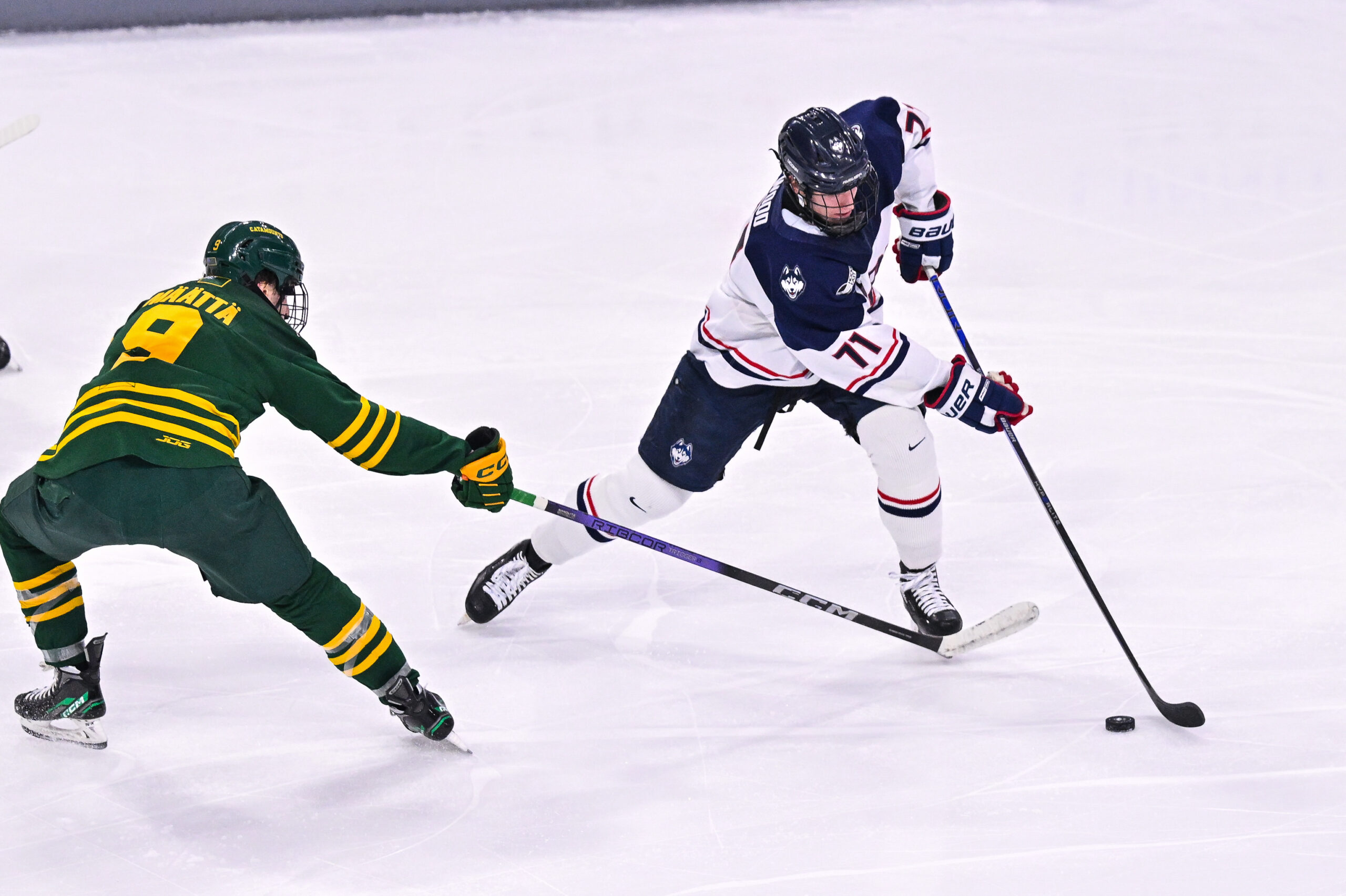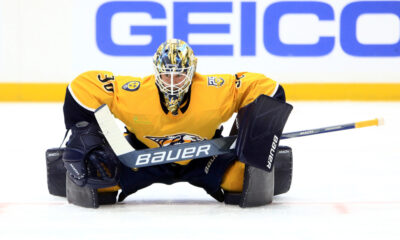Heading into the 2023 NHL Entry Draft last summer, Matthew Wood was projected as a consensus first-round pick.
But nearly everyone, myself included, had major concerns about his skating ability. Evaluators described it as “grim,” “sluggish,” and “some of the worst if he makes the NHL.”
When the Nashville Predators selected Wood 15th overall (I had him ranked 17th on my draft board), I wrote, “his strengths are clear, and his weaknesses may be clearer.” On his skating mechanics, I added: “While his edgework isn’t half bad, he lacks some necessary knee bend. His stride extensions are inconsistent, and his recoveries don’t often come back under center. Most notably, his accelerating speed just isn’t at an NHL level.”
Wood’s first post-draft season, if you’re only looking at box scores, wasn’t quite what you wanted to see. In 35 games for the University of Connecticut (UConn) Huskies, Wood improved to score 16 goals (compared to 11 last year) but totaled just 28 points (versus 34). He went on a big six-game goal drought after the 2024 World Junior Championship, where he was mostly relegated to be Canada’s 13th forward.
On the other hand, Wood proved he isn’t just a power-play merchant as 21 of his 28 points were primary ones scored at even strength. He recorded a primary point on 80.8% of the even-strength goals he was on the ice for and totaled an impressive 2.52 per 60 minutes.
But the thing that his NHL future may entirely hinge on remains his skating. Let’s dive into the game tape to see what improved and what still needs work.
Matthew Wood’s (#71, white) skating issues can be common amongst bigger prospects. His acceleration and anticipation aren’t great, but after a few strides, his speed is okay. Another familiar trait can be the lack of coordination between a player’s hands and feet. Notice above how Wood picks up speed through the neutral zone, but when the defender closes his gap, Wood’s feet shut down and he attempts to do all the work with his hands. Wood has above-average stickhandling skills, but NHL defenders will be able to shut that down most of the time.
As demonstrated on the shift above, Wood showed some improvement in this area during this campaign, taking different angles against defenders and trying to maintain his speed to create opportunities for teammates. Most importantly, he diversified his puck handling more, pushing the puck out in front of his body far less.
In my scouting last year, I noted that Wood’s strides don’t always recover under his torso. That leads to a wide skating stance that can be hard to accelerate from. That issue persists, but I noticed Wood getting more creative in those wider stances, where it can be difficult to dispossess him. Take the clip above as an example, Wood peels off the boards and dishes the puck to the goal line. His legs are wide as he carves to the net, but in such a small space, all Wood needs to do is dig in his edges to power himself to the doorstep to bury a goal.
In terms of anticipation, Wood relied less on his tendency to overskate plays and recover with wide circles. Take the shift above, where he pivots quickly as the Northeastern defender passes the puck up the ice, recovering possession in the neutral zone. Better anticipation leads to better acceleration, and Wood jumps quickly into a give-and-go mode, finding open ice rushing up the ice. While his teammate misses him with the pass, he’s already in a position to pressure the puck carrier and force a giveaway.
Matthew Wood hasn’t eradicated his overskating or wide turns, but his recoveries have certainly improved. When he first approaches the puck carrier in the defensive zone in the clip above, he takes a wide turn to get back into the play. But when Northeastern’s #15 makes a move on him, he tightens that pivot and uses some strong crossover steps to keep up and force a low-danger shot.
Matthew Wood is a cerebral hockey payer and anticipating movements quicker will always lead to better positioning. In the clip above, he reads the foot race above the faceoff circle well, starting his engine early, and ultimately outskating his teammate through the neutral zone.
When he backchecks, he displays almost a complete reversal of his worst skating stride tendencies: good knee bend, fuller strides, and complete recoveries under his torso. The result is he’s back in time to help his teammates kill the play.
Here’s another example of much better stride mechanics from Wood. And despite starting a few strides back, you can see a difference in his speed as he crashes the zone and buries a two-on-one goal.
By no means has Matthew Wood solved his skating issues entirely, but he took encouraging steps this season. As he heads to the transfer portal and likely to a bigger program next year (a move undoubtedly orchestrated by Nashville), Wood will need to keep improving his hand and feet coordination, his anticipation, and his speed with more consistent strides to be a truly dominant college hockey player.

















